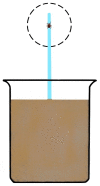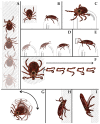Behavioral Repertoire on a Vertical Rod-An Ethogram in Dermacentor reticulatus Ticks
- PMID: 36556451
- PMCID: PMC9787772
- DOI: 10.3390/life12122086
Behavioral Repertoire on a Vertical Rod-An Ethogram in Dermacentor reticulatus Ticks
Abstract
Ticks are important vectors of pathogens that endanger humans and animals. Study of their behavior under laboratory conditions is important for both predicting their behavior in natural conditions and understanding their involvement in transmission cycles of pathogens, which may lead to effective prevention of tick-borne disease transmission or establishment of effective preventive measures. The aim of our study was to describe the behavior of D. reticulatus ticks using laboratory assay. We focused on the description of individual behavioral units during their vertical movement. The assay consisted of glass beakers filled with sand and an embedded glass rod. We observed 10 different behavioral units, 4 of which have not yet been described: body posturing called "jogger", leg grooming, and body or leg jerking. The most frequent tick behavior observed was an upwards positioning of the two front legs while the body remained motionless (88.9%). Other common observations were both horizontal (63%) and vertical (58.0%) body posturing with all legs lowered, followed by questing behavior (51.9%). Ticks spent the most time questing (75.2%), crawling (54.7%), and grooming legs on the right side (23%). We did not observe any differences between males and females.
Keywords: Dermacentor reticulatus; behavior; ethogram; tick; vertical movements.
Conflict of interest statement
The authors declare no conflict of interest.
Figures


References
-
- Ehrmann S., Liira J., Gärtner S., Hansen K., Brunet J., Cousins S.A.O., Deconchat M., Decocq G., De Frenne P., De Smedt P., et al. Environmental Drivers of Ixodes Ricinus Abundance in Forest Fragments of Rural European Landscapes. BMC Ecol. 2017;17:31. doi: 10.1186/s12898-017-0141-0. - DOI - PMC - PubMed
Grants and funding
LinkOut - more resources
Full Text Sources

